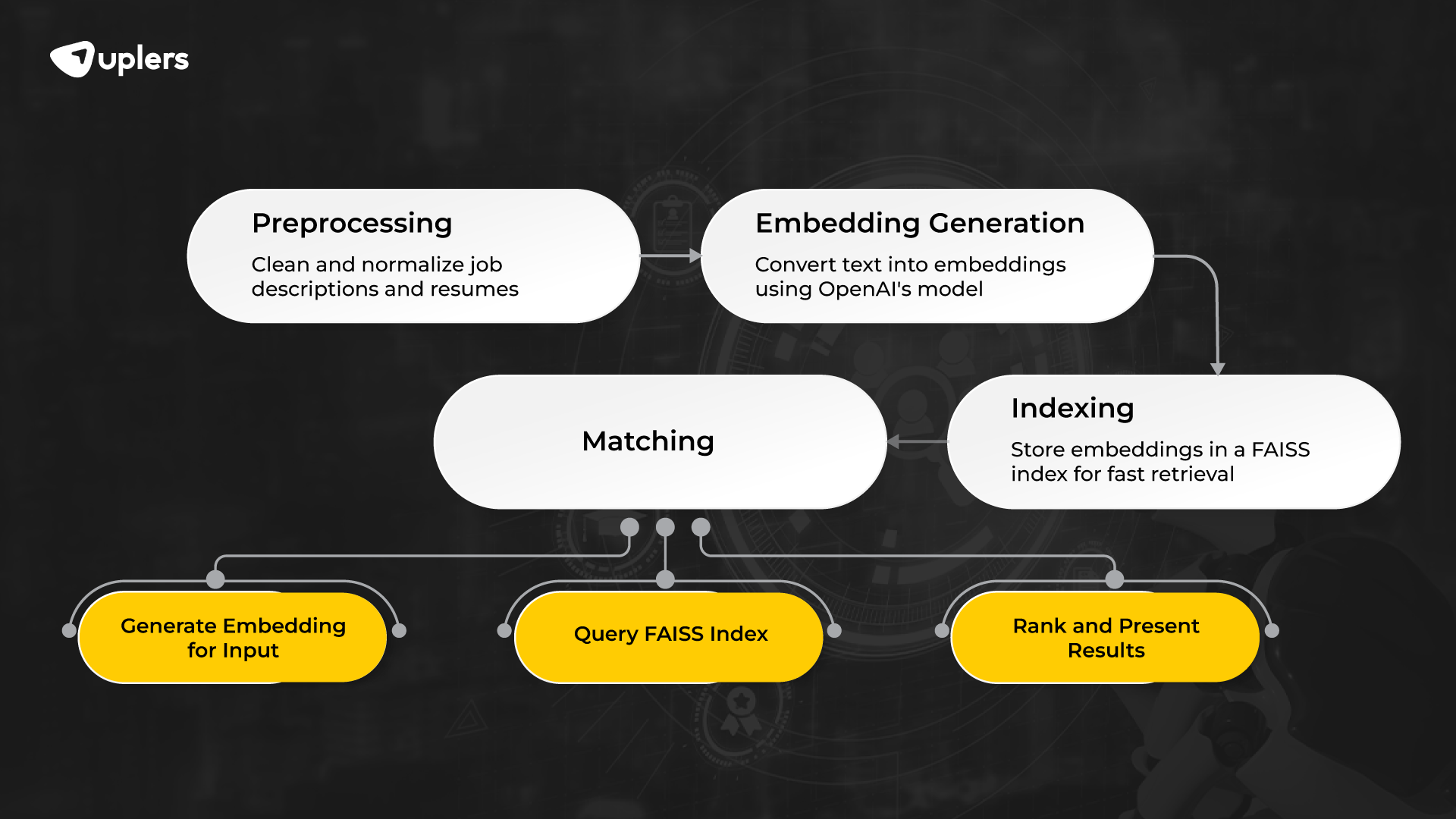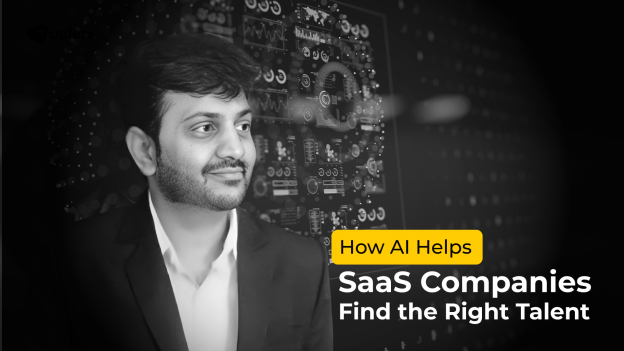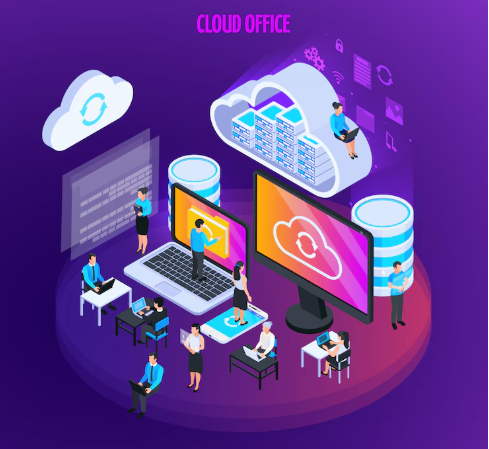The art of hiring has always been about striking the perfect balance—matching the right candidate to the right job. However, traditional hiring methods often struggle to scale effectively, especially when dealing with large datasets and nuanced roles. To address these challenges, Uplers has developed an innovative AI-powered matchmaking algorithm designed to bridge the gap between job descriptions and talent resumes with unprecedented precision and efficiency.
Here’s a detailed look into how this technology is revolutionizing talent acquisition.
The Core Idea
At the heart of this AI-powered solution are two cutting-edge technologies:
- OpenAI’s text-embedding-ada-002 model: A tool for semantic understanding of textual data, capable of transforming complex information into machine-readable formats.
- Meta’s FAISS (Facebook AI Similarity Search): A high-performance library for similarity searches, optimized for handling massive datasets with speed and accuracy.
Together, these technologies form a robust system that delivers near-instantaneous matches between job descriptions and resumes, enabling recruiters to find top talent effortlessly.
Visualization –
AI Tools for Advanced Semantic Understanding and High-Performance Similarity Search
- Overview Section:
- OpenAI’s Text-Embedding-ADA-002 Model: Visualize as a network of interconnected nodes, representing how textual data is transformed into rich embeddings that capture nuanced meaning. Use an icon of complex text transforming into simplified, linked data clusters. Caption: “Extract deep semantic insights, enabling complex text to be effectively understood by AI systems.”
- Meta’s FAISS Library: Depict as a structured data grid, emphasizing its efficiency in rapid similarity searches. Use an illustration of a magnifying glass zooming into dense clusters of data points, conveying precision in handling massive datasets. Caption: “Accelerated similarity search with the capacity to manage extensive datasets efficiently.”
- Key Features Section:
- OpenAI’s Text Embedding:
- Graphics that emphasize “Deep Semantic Understanding,” “Machine-Readable Representations,” and “Versatile Applications.” Use icons like gears for adaptability, and a lightbulb for innovative insights.
- Meta’s FAISS:
- Visual elements highlighting “Scalability,” “Ultra-Fast Search Speed,” and “High Precision.”
- Use a speedometer to denote performance and an expanding grid for scalability.

- Use Cases Section:
- Semantic Understanding (Text Embedding Model):
- Illustrate an example where a paragraph is transformed into a cluster of embeddings, showcasing applications like “sentiment analysis” or “topic categorization.”
- Similarity Search (FAISS):
- Visualize a dataset of articles, with similar ones being highlighted and grouped based on user queries.
- Include an icon of a magnifying glass for emphasis on efficient similarity-based retrieval.
- Flow Diagram (Interaction between Both)
- Develop a visual flow that demonstrates how text embeddings from ADA-002 feed into FAISS for similarity searches. Represent ADA-002 transforming text into vectors, and FAISS subsequently retrieving similar vectors with high efficiency.
Key Technical Components
1. Text Embeddings with OpenAI’s text-embedding-ada-002
The text-embedding-ada-002 model represents text (e.g., job descriptions or resumes) as numerical vectors in a multi-dimensional space. This approach captures the semantic relationships between words, phrases, and contexts.
Why embeddings?
- They enable the algorithm to understand subtle relationships, even when terminology differs.
- For example, a job description for a Data Scientist and a resume mentioning Machine Learning Engineer might use different words but describe highly related skill sets. Text embeddings ensure these connections are identified.
2. Efficient Indexing with FAISS
FAISS is designed for high-dimensional similarity searches. It indexes embeddings efficiently, enabling rapid querying for matches. This makes it possible to process large volumes of resumes and job descriptions in real-time.
Matchmaking Workflow
The system follows a seamless, end-to-end workflow:
- Preprocessing: Job descriptions and resumes are cleaned and normalized to eliminate inconsistencies (e.g., typos or non-standard formatting).
- Embedding Generation: Text is converted into embeddings using OpenAI’s model.
- Indexing: The embeddings are stored in a FAISS index for fast retrieval.
- Matching: When a job description or resume is added:
- An embedding is generated for the input.
- The FAISS index is queried to find the top k closest matches.
- Results are ranked based on similarity scores and presented to the user.
Challenges and Solutions
1. Scalability
- Challenge: Handling thousands of resumes and job descriptions without performance degradation.
- Solution: Batch processing and periodic re-indexing keep the system agile, even with large datasets.
2. Accuracy vs. Speed
- Challenge: Balancing rapid responses with precise matchmaking.
- Solution: FAISS’s approximate search configuration ensures fast queries without significantly compromising accuracy.
3. Contextual Understanding
- Challenge: Adapting to industry-specific jargon and context.
- Solution: Fine-tuned preprocessing and domain-specific adjustments enhance semantic matching.
The Results
This system transforms hiring by:
- Accelerating candidate selection: Recruiters can surface top candidates in seconds.
- Streamlining hiring processes: Reduces manual effort, saving time and resources.
- Empowering job seekers: Provides tailored job recommendations that align with their skills and aspirations.
Looking Ahead
While the current solution is a significant advancement, the future holds even greater potential. Upcoming enhancements include:
- Feedback loops: Continuous learning from user interactions to improve accuracy.
- Dynamic job-resume adjustments: Leveraging large language models to refine matchmaking in real-time.
- Multilingual support: Expanding capabilities to connect global talent pools.
Building this system has been both a challenge and an opportunity, blending state-of-the-art AI tools with the real-world complexities of recruitment.
















